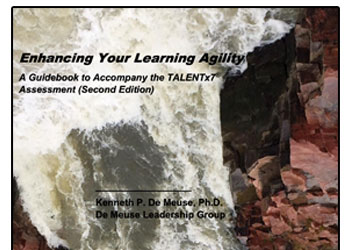Developmental Guidebook (2nd Edition)

Being informed of one’s scores on learning agility is not sufficient. One has to make a commitment to apply this feedback and improve as a leader. Ultimately, the individual’s behaviors need to change for development to occur. Venturing outside of one’s comfort zone requires dedication, discipline, and a strong desire to change. It also requires assistance on which behaviors to change and guidance on how one can change them. In Enhancing Your Learning Agility: A Guidebook to Accompany the TALENTx7 Assessment, concrete information for developing one’s learning agility is provided. Specific examples of effective leader behaviors as well as developmental recommendations are presented for each of the different facets of learning agility. The Guidebook is a resource coaches can provide individuals after the feedback session. It is a particularly useful tool to provide individuals following group feedback sessions.
Developing Learning Agility
The following sections are presented for each of the seven facets of learning agility that the TALENTx7 Assessment measures:
- Key leadership competencies
- Effective leader behaviors
- Potential causes for a low learning agility facet score
- Behavioral suggestions on how to enhance one’s learning agility for the facet
- Recommended life and work-related activities
- Recommended organizational positions and job assignments
- Recommended books to read that will stimulate growth and development of the facet
Scaling Back Overuse
Conventional wisdom in leadership development is that you can’t have too much of a good thing. Yet, research has found that leaders often lose their jobs when their strengths become weaknesses through overuse. An asset – when pushed to the extreme – can become a liability. For example, managerial confidence is a strength. However, when pushed too far, it can be perceived as arrogance or narcissism. In the Guidebook, we (a) highlight specific examples of overuse behaviors for each of the seven facets of learning agility, (b) identify potential underlying causes for the behavior, and (c) suggest methods on how to moderate or eliminate this behavior.
COST
$75 Hardcopy
$45 Electronic Copy
